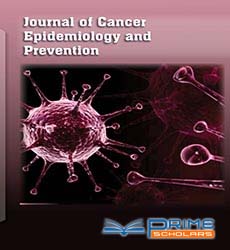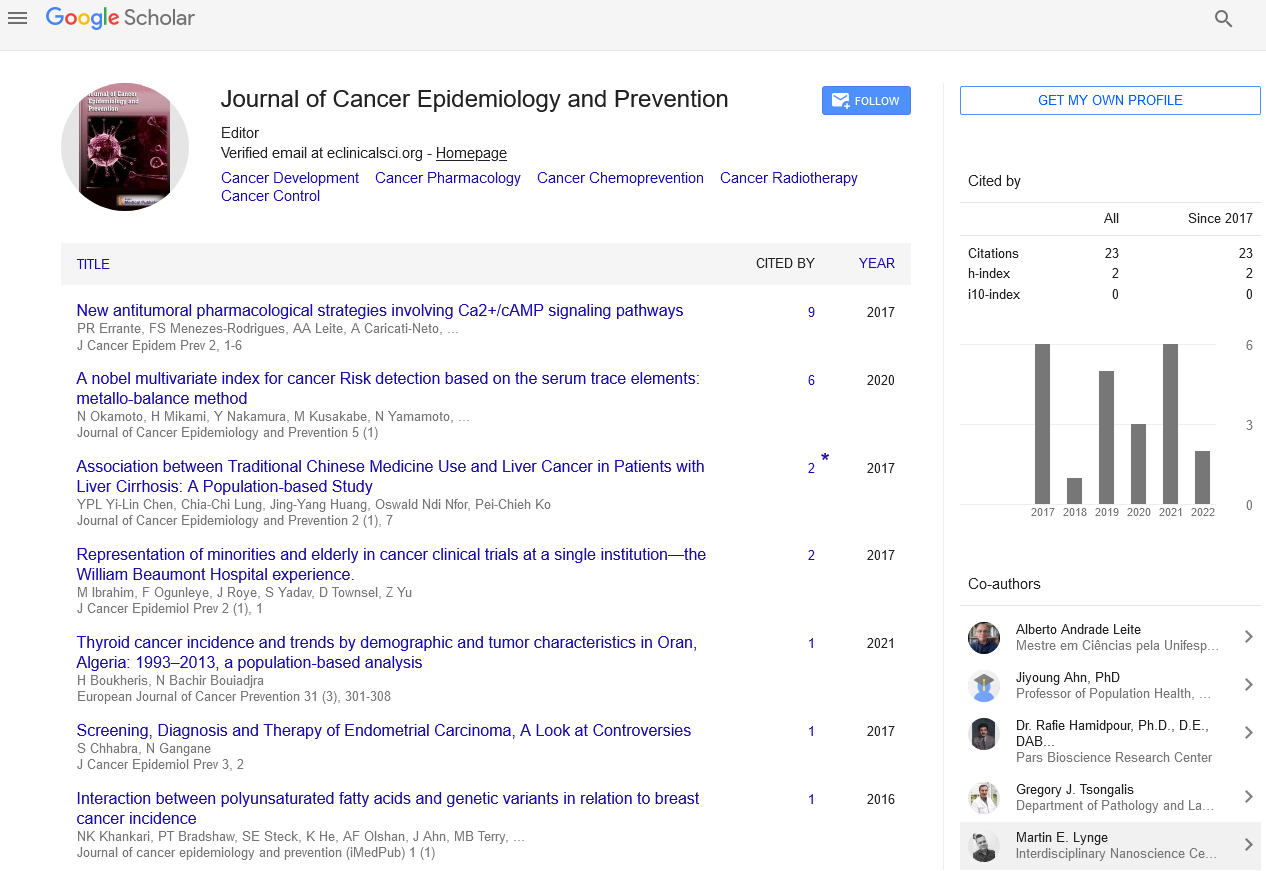Perspective - (2023) Volume 8, Issue 1
Enzymes that Alter the Methylation of Histones for the Treatment of Skin Cancer
David Alland*
Department of Radio Oncology, University of Malaysia, Malaysia
*Correspondence:
David Alland,
Department of Radio Oncology, University of Malaysia,
Malaysia,
Email:
Received: 31-Jan-2023, Manuscript No. IPJCEP-23-15870;
Editor assigned: 02-Feb-2023, Pre QC No. IPJCEP-23-15870 (PQ);
Reviewed: 16-Feb-2023, QC No. IPJCEP-23-15870;
Revised: 21-Feb-2023, Manuscript No. IPJCEP-23-15870 (R);
Published:
28-Feb-2023, DOI: 10.36648/IPJCEP.23.08.004
Introduction
Skin cancer risk can be decreased by reducing indoor tanning,
avoiding midday sun exposure, applying sunscreen, and avoiding
tobacco products. Due to the presence of UV light, it is essential
to limit sun exposure and avoid tanning beds. UV light is
known to alter DNA in skin cells, causing damage. On the skin,
the mutated DNA can result in tumours and other growths.
There are additional risk factors in addition to UV exposure.
There is insufficient evidence to support or refute skin cancer
screening. Nutrient and cell reinforcement enhancements have
not been found to be effective in preventing disease.
Description
There are no clinical trials to support the hypothesis that dietary
changes can lower melanoma risk, despite some epidemiological
evidence to the contrary. Sunscreens commonly contain
zinc oxide and titanium dioxide to provide broad UVA and UVB
protection. Despite the fact that specific food varieties might
bring down the gamble of getting a burn from the sun, utilizing
sunscreen offers essentially more security. Individuals with
xeroderma pigmentosum who applied T4N5 liposome salve to
their skin had a slower pace of basal cell carcinomas showing
up, and individuals who take acitretin by mouth might have
better skin security after kidney transfers, as per a meta-examination
of skin malignant growth counteraction in individuals
at high gamble. A vaccine that stimulates the production of a
protein that is essential to the antioxidant network on the skin
could increase people’s protection against skin cancer, according
to research that was published in January 2022 by the Oregon
State University College of Pharmacy. This study found that
the vaccine could do this. Radiation therapy, impaired immune function, long-term arsenic exposure, and exposure to ultraviolet
light are all risk factors. When a child is young, exposure to
ultraviolet light is especially harmful. Another common source
of ultraviolet radiation is tanning beds. Frequently, a skin examination
and a tissue biopsy are used to confirm the diagnosis.
It is still unknown how sunscreen affects the likelihood of developing
basal cell cancer. Typically, treatment involves surgical
removal. If the cancer is small, this can be accomplished with
a straightforward excision; On the other hand, Mohs surgery
is typically recommended. Cryosurgery, topical chemotherapy,
photodynamic therapy, laser surgery, electrodessication and
curettage, and imiquimod, a medication that is applied directly
to the skin and stimulates the immune system, are additional
options. Chemotherapy or targeted therapy may be used in
rare cases of distant spread. At least 32% of all cancers worldwide
are caused by basal cell carcinoma. About 80% of skin
cancers, with the exception of melanoma, are basal-cell-based.
About 25% of white women and 35% of white men in the United
States have BCC at some point in their lives.
Cancer is linked to radiation, including ultraviolet radiation and
radioactive substances. UV light, mostly from sunlight, is the
cause of many non-melanoma skin cancers. Medical imaging
and radon gas are two examples of sources of ionizing radiation.
Mutagens produced by ionizing radiation are not particularly
potent. Passive smoking and residential radon gas exposure,
for instance, both raise cancer risk. When combined with
other agents that have the potential to cause cancer, such as
radon and tobacco smoke, radiation becomes a more potent
source of cancer. Regardless of age, radiation can cause cancer
in the majority of an animal’s body. Radiation-induced leukemia
affects children twice as frequently as it does adults; 10
times more harm is caused by radiation exposure before birth.
Conclusion
Utilization of ionizing radiation for clinical purposes is a small
but growing source of radiation-induced malignant growths.
Other types of cancer can be treated with ionizing radiation,
but it can also cause a second type of cancer. It is also utilized in
some methods of medical imaging. Melanoma and other skin
cancers can develop from prolonged sun exposure. There is a
lot of evidence to suggest that ultraviolet radiation, particularly
the non-ionizing medium wave UVB, is responsible for the majority of non-melanoma skin cancers the most common type of
cancer worldwide.
Acknowledgement
None.
Conflict Of Interest
The authors declare that they have no conflict of interest.
Citation: Alland D (2023) Enzymes that Alter the Methylation of Histones for the Treatment of Skin Cancer. J Cancer Epidemiol Prev. 08:004.
Copyright: © 2023 Alland D. This is an open-access article distributed under the terms of the Creative Commons Attribution License, which permits unrestricted use, distribution, and reproduction in any medium, provided the original author and source are credited.

